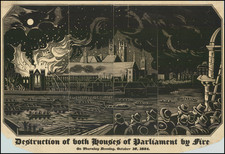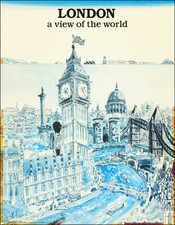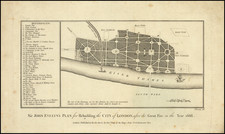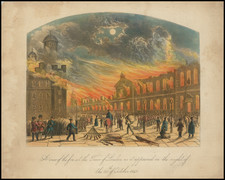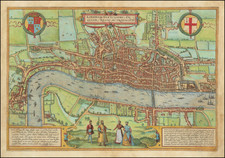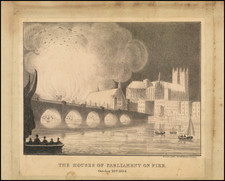"The Most Important... and the Most Accurate of the Pre-Fire Panoramas of London." - Howgego
This is a fine example of the most famous of all bird's-eye views of London, produced by the Bohemian master-engraver Wenceslaus Hollar.
This view is a superlative piece for one of the world's longstanding centers of trade and finance. The view captures the city as it stood during the Caroline period, following sketches that Hollar made from 1636 to 1642, and was first printed in about 1647, in Antwerp. The view has been called the most accurate image of London before the fire (Howgego) because of the keen eye of its engraver and the depth of detail it shows.
This piece shows Hollar's mastery of the medium of copperplate engraving. Hollar's rare eye for capturing sights as they are and not as they should be led to his timeless images that only the finest old masters of northern Europe could produce. Fortunately for those cartographically-inclined, Hollar was also trained as a mapmaker, and his most remarkable pieces come from the combination of these two capabilities and led to the creation of some of the finest maps, city views, and topographical works ever produced.
The Long View stands at the apex of Hollar's oeuvre. On it, we see countless monuments of 17th-century London as captured from St. Mary's Tower (now part of Southwark Cathedral). At the west end of the present example, we see Salsbury House and Convent Garden on the northern bank. On the south bank from these, the Globe and Bear Baiting theaters (erroneously swapped) are shown, with this being one of the most often reproduced images of the Globe prior to its 1644 demolition. Moving eastwards, St. Paul's appears and the layout of the area destroyed in the Fire retains its Elizabethan layout. At the eastern end of the map, London Bridge is beautifully engraved, and past this we see the Tower, at the outskirts of the city. The Thames is filled with countless ships, including the eel ships from which Dutch merchants sold eels to Londoners. Decorative elements line the sky, and the title cartouche, reading simply "London" is adorned with two lions and a coat of arms.
This is, without a doubt, one of the greatest engraved views of London ever produced.
Publication History
The Hollar Long View was engraved on six plates (with the sixth plate split amongst two end sheets, not present in this copy) following sketches made during the period 1636 to 1642. The engraving is known to have been made in Antwerp, where Hollar returned to in 1645. Pennington suggests that the first state was engraved in 1647.
Five of the sheets are known in a second state. These update the city through the 17th century, showing the Maypole (1661), the Monument (1677) and St. Pauls's Dome (1697). However, St. Paul's Dome is incorrectly depicted, suggesting that this final update was made between the completion of the Monument and the completion of St. Paul's Dome (i.e., 1677-1697).
Wenceslaus Hollar
Two features combine to make Hollar's work stand out among the great engravers of the 17th century: his sharp eye that captured a realistic view of objects, people, and places, and his wide travels, during which he made copious sketches that he later turned into engravings. Of the most important of his travels were those that he made to England, where he spent many years in the service of Lord Arundel, a great patron of the arts.
This period in England allowed Hollar the opportunity to travel extensively through the country and to produce a number of Anglo-centric engravings that are today among the most desirable of his output. This period was also a tumultuous one, with the English Civil War starting at the end of his tenure in the country. Having experienced the ruin of his own family following the Sack of Prague, the fate of his adopted country and his English patrons during the interregnum marked Hollar profoundly. Following the onset of conflict, Hollar returned to the Low Countries but continued to work on his English material. It was during this period, in Antwerp, that the Long View was produced.
Hollar continued to travel through his life and would return to England during the restoration. Yet, he never managed to again capture the success of his pre-Restoration period and would die in extreme poverty in 1677.
States
Plates 1, 2, and 3 (from left) are in Pennington's second state (of two, recognizable by the addition of the May Pole, the completion of St. Paul's cathedral, and the addition of the Monument, respectively). Plates 4 and 5 are in the first state (of one).
Rarity
The view is known in eight copies. These are: the British Museum (two copies; one first state; one mixed first and second state, lacking the endsheets); the Royal Library, Windsor (two copies; one first state; one mixed state, lacking the endsheets) the Ashmolean (two copies; one first state; one mixed first and second state); University of Chicago (states undetermined); and a private collection.
The view has appeared twice on the market since 1999, once at Christie's, The London Sale, Lot 1, and then (perhaps the same example) in the London trade in 2016 for £275,000.
A Note on the Endsheets
This example, like one at the British Museum and another at the Royal Library, Windsor, lacks the two endsheets that bear much of the dedicatory and imprint information for the view. These three examples are mixed first and second states, indicating that they were printed later, probably after 1677. It has been hypothesized that the endsheets were often discarded because of their positive discussion of Charles II - an unfavorable sentiment for some, following the English Civil War. It is also possible that the plate was lost or discarded later, when Hollar's plates were acquired by another publisher. It should be noted that the endsheets were printed together, from a single copperplate, to be cut and joined by the printer.











